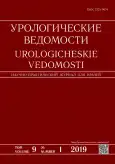Лапароскопическая нефрэктомия в условиях карбоксиперитонеума низкого давления у пациентов с аутосомно-доминантным поликистозом почек
- Авторы: Дайнеко В.С.1, Невирович Е.С.2, Ананьев А.Н.2, Ульянкина И.В.1, Резник О.Н.1,2,3
-
Учреждения:
- ГБУ «Санкт-Петербургский научно-исследовательский институт скорой помощи им. И.И. Джанелидзе»
- ФГБОУ ВО «Первый Санкт-Петербургский государственный медицинский университет им. акад. И.П. Павлова» Минздрава России
- ФГБОУ ВО «Северо-Западный государственный медицинский университет им. И.И. Мечникова» Минздрава России
- Выпуск: Том 9, № 1 (2019)
- Страницы: 17-22
- Раздел: Оригинальные статьи
- URL: https://journals.rcsi.science/uroved/article/view/11261
- DOI: https://doi.org/10.17816/uroved9117-22
- ID: 11261
Цитировать
Аннотация
Введение. Аутосомно-доминантный поликистоз почек (АДПП) — одно из самых распространенных наследственных заболеваний, ведущих к развитию терминальной почечной недостаточности. По современным представлениям, нефрэктомию поликистозно измененных почек таким пациентам выполняют при возникновении осложнений, а также с целью подготовки к трансплантации почки. Создание напряженного карбоксиперитонеума приводит к резорбции углекислого газа и развитию у пациента гиперкапнии и респираторного ацидоза, что с учетом возраста больных, а также высокой частоты встречаемости сердечно-сосудистой и клапанной патологии у пациентов с АДПП может приводить к развитию тяжелых осложнений. Решением этой проблемы является выполнение лапароскопической нефрэктомии в условиях карбоксиперитонеума низкого давления (ЛНД).
Материалы и методы. В период с 2013 по 2018 г. в клинике выполнено 55 монолатеральных лапароскопических нефрэктомий 36 пациентам с АДПП. В ходе исследования выделено две группы больных. В исследуемую группу вошли 8 пациентов, которым в связи с диагностированной на дооперационном этапе сердечно-сосудистой патологией выполняли ЛНД (12 операций). Вторая группа была представлена 28 больными, которые были прооперированы лапароскопически с созданием напряженного карбоксиперитонеума (41 операция). Рабочее пространство при ЛНД создавали с помощью лапаролифта — механического устройства для подъема брюшной стенки над органами брюшной полости.
Результаты. Средняя длительность операции в группах составили соответственно 126 ± 18 и 114 ± 11 минут (p < 0,05). Значимо отличался объем интраоперационной кровопотери: в группе сравнения — 225 ± 45 мл, в исследуемой группе — 440 ± 76 мл (p < 0,05). Средний уровень pCO2 и pH крови в исследуемой группе составил 38,2 ± 2,7 мм рт. ст. и 7,371 ± 0,021, в группе сравнения — 44,4 ± 3,8 мм рт. ст. и 7,231 ± 0,035 (p < 0,05). Среди больных, которым была выполнена ЛНД, имел место один летальный исход. Частота послеоперационных осложнений в исследуемой группе оказалась равна 16,6 % (2), в группе сравнения — 12,2 % (5).
Выводы. Лапароскопическая нефрэктомия в условиях карбоксиперитонеума низкого давления позволяет избежать развития у пациента гиперкапнии и респираторного ацидоза и предотвратить тяжелые сердечно-сосудистые осложнения, несмотря на высокий риск их развития среди больных с АДПП.
Ключевые слова
Полный текст
Открыть статью на сайте журналаОб авторах
Василий Сергеевич Дайнеко
ГБУ «Санкт-Петербургский научно-исследовательский институт скорой помощи им. И.И. Джанелидзе»
Автор, ответственный за переписку.
Email: dvsis@rambler.ru
врач-хирург
Россия, Санкт-ПетербургЕвгений Станиславович Невирович
ФГБОУ ВО «Первый Санкт-Петербургский государственный медицинский университет им. акад. И.П. Павлова» Минздрава России
Email: enevirovich@gmail.com
канд. мед. наук, заведующий урологическим отделением
Россия, Санкт-ПетербургАлексей Николаевич Ананьев
ФГБОУ ВО «Первый Санкт-Петербургский государственный медицинский университет им. акад. И.П. Павлова» Минздрава России
Email: alananyev@yandex.ru
канд. мед. наук, заведующий отделением трансплантации почки
Россия, Санкт-ПетербургИрина Владимировна Ульянкина
ГБУ «Санкт-Петербургский научно-исследовательский институт скорой помощи им. И.И. Джанелидзе»
Email: irina-spb.yl@mail.ru
канд. мед. наук, врач-нефролог. Санкт-Петербургский координационный центр органного донорства
Россия, Санкт-ПетербургОлег Николаевич Резник
ГБУ «Санкт-Петербургский научно-исследовательский институт скорой помощи им. И.И. Джанелидзе»; ФГБОУ ВО «Первый Санкт-Петербургский государственный медицинский университет им. акад. И.П. Павлова» Минздрава России; ФГБОУ ВО «Северо-Западный государственный медицинский университет им. И.И. Мечникова» Минздрава России
Email: onreznik@gmail.com
д-р мед. наук, руководитель отдела трансплантологии и органного донорства; руководитель отдела трансплантологии; профессор кафедры хирургических инфекций
Россия, Санкт-Петербург;Список литературы
- Jacquet A, Pallet N, Kessler M, et al. Outcomes of renal transplantation in patients with autosomal dominant polycystic kidney disease: a nationwide longitudinal study. Transpl Int. 2011;24(6):582-587. https://doi.org/10.1111/j.1432-2277.2011.01237.x
- Furlano M, Loscos I, Martí T, et al. Autosomal dominant polycystic kidney disease: clinical assessment of rapid progression. Am J Nephrol. 2018;48(4):308-317. https://doi.org/10.1159/000493325.
- Torres VE, Harris PC, Pirson Y. Autosomal dominant polycystic kidney disease. Lancet. 2007;369(9569):1287-1301. https://doi.org/10.1016/S 0140-6736(07)60601-1.
- Ars E, Bernis C, Fraga G, et al. Spanish guidelines for the management of autosomal dominant polycystic kidney disease. Nephrol Dial Transplant. 2014;29(4):95-105. https://doi.org/10.1093/ndt/gfu186.
- Moga MA, Arvatescu CA, Pratilas GC, et al. The role of gasless laparoscopy in differential diagnosis of acute abdomen. Hippokratia. 2015;19(1):69.
- Мазитова М.И., Ляпахин А.Б. Безгазовая лапароскопия в гинекологии как альтернатива классической эндоскопии // Казанский медицинский журнал. – 2008. – Т. 89. – № 4. – С. 498–502. [Mazitova MI, Lyapahin AB. Bezgazovaya laparoskopiya v ginekologii kak al’ternativa klassicheskoj ehndoskopii. Kazanskij medicinskij zhurnal. 2008;89(4):498-502. (In Russ.)]
- Величко Е.А., Некрасов А.Ю., Сергеев А.В. Безгазовая лапароскопия в лечении пациентов с острым деструктивным холециститом и повышенным анестезиолого-операционным риском // Клиническая геронтология. – 2015. – № 11-12. – С. 7. [Velichko EA, Nekrasov AYu, Sergeev AV. Bezgazovaya laparoskopiya v lechenii pacientov s ostrym destruktivnym holecistitom i povyshennym anesteziologo-operacionnym riskom. Klinicheskaya gerontologiya. 2015;(11-12):7. (In Russ.)]
- Аль-Шукри С.Х., Невирович Е.С., Аль-Шукри А.С., и др. Опыт применения лапаролифта при лапароскопической радикальной простатэктомии // Урологические ведомости. – 2015. – Т. 5. – № 1. – С. 52. [Al’-Shukri SH, Nevirovich ES, Al’-SHukri AS et al. Opyt primeneniya laparolifta pri laparoskopicheskoj radikal’noj prostatehktomii. Urologicheskie vedomosti. 2015;5(1):52. (In Russ.)]
- Yu J, Wu J, Yu L, et al. Gasless laparoscopic surgery plus abdominal wall lifting for giant hiatal hernia — our single-center experience. Journal of Huazhong University of Science and Technology [Medical Sciences]. 2016;36(6):923-926. https://doi.org/10.1007/s11596-016-1685-5.
- Xia PT, Yusofu M, Han HF, et al. Low-pressure pneumoperitoneum with abdominal wall lift in laparoscopic total mesorectal excision for rectal cancer: Initial experience. World J Gastroenterol. 2018;24(11):1278-1284.
Дополнительные файлы








